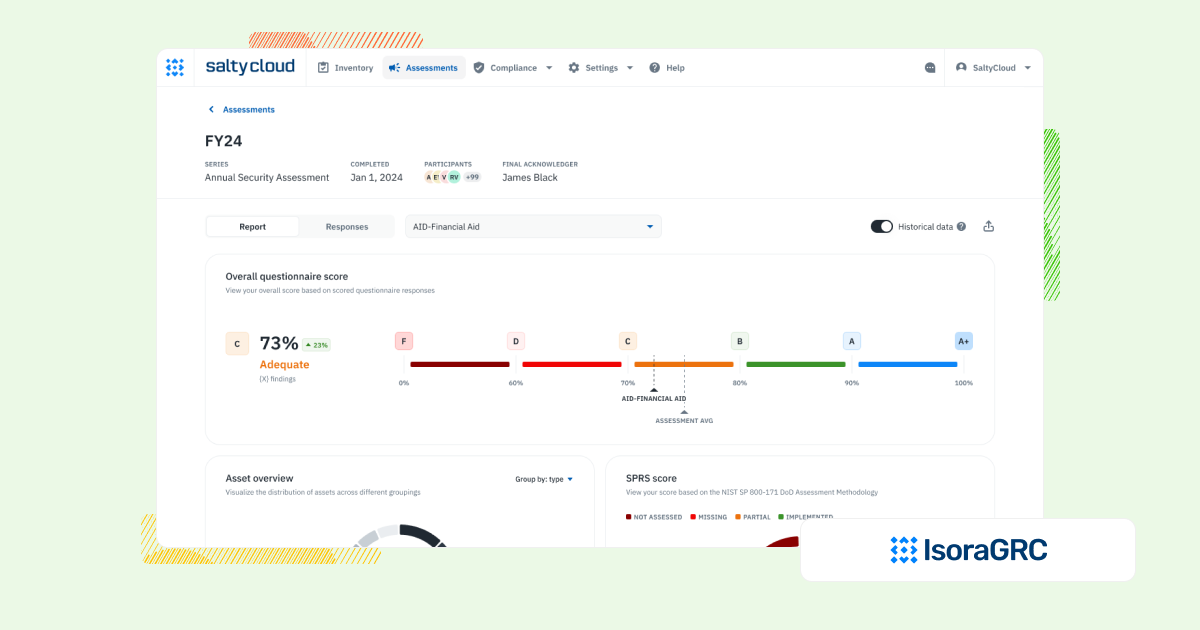
Security teams today need more than checklists—they need flexible, collaborative workflows that support real-world risk management.
ZenGRC and AuditBoard are part of a growing class of all-in-one GRC platforms. They offer broad compliance and audit coverage across the enterprise, but that breadth often comes with tradeoffs: rigid workflows, siloed modules, and low adoption among the people doing the actual work.
Security teams need platforms that simplify—not complicate—risk management. When GRC tools are designed to serve everyone, they often fail to serve security well.
Isora GRC takes a focused approach. It’s built specifically for IT and third-party risk workflows, helping security teams run assessments, manage inventories, and track risks—without the friction of bloated GRC suites.
Choosing the Right Platform for IT Risk Management
ZenGRC and AuditBoard offer robust functionality for compliance and audit programs, but they weren’t built with the daily workflows of security teams in mind. Long setup times, audit-first design, and complex interfaces often get in the way of adoption and impact.
Isora GRC is different. It’s purpose-built for information security risk management and third-party risk management—providing structured workflows for assessments, inventories, exception management, and risk registers. It’s fast to deploy, intuitive to use, and easy to adopt across technical and non-technical teams alike.
The Workflow That Matters: Managing IT Risks and Compliance
Security teams face a continuous stream of tasks: assessing internal departments and third parties, collecting and reviewing evidence, maintaining inventories, identifying risks, and coordinating remediation. None of that works without structured workflows and shared visibility.
Many traditional GRC tools weren’t designed to support this kind of cross-functional, real-time work. Their audit-centric foundations and generalized configurations make it harder to keep pace with risk.
Isora GRC brings these workflows together in a single, focused platform—giving teams the tools they need to move quickly, stay aligned, and manage risk proactively.
How Each Platform Supports IT Risk Management Workflows
| Workflow Area | ZenGRC | AuditBoard | Isora GRC |
| Assessment Management | ZenGRC makes assessments simple to set up and track. Templates help speed things up, but users say deeper customization options are limited without extra workarounds. | AuditBoard handles assessments well, but admin tasks take time. Adding fields or editing steps can feel slow and tricky. Online edits sometimes cause data loss. | Centralized, intuitive assessment dashboard across business units, vendors, and assets. Built specifically for security teams. |
| Questionnaire Delivery & Completion | Questionnaire management feels smooth for small projects. For larger surveys, users report some challenges with tracking responses and linking them cleanly back to controls. | Survey tools link into the platform, which helps. Still, managing files in projects feels clunky. The tool stores documents but doesn’t fully support team collaboration. | Customizable and prebuilt questionnaires for frameworks like NIST, ISO, GLBA, HIPAA, and more. Designed for internal and external collaboration. |
| Inventory Tracking | Asset and vendor inventories are easy to start but can become siloed. Some users want tighter integration between inventories and risk workflows without needing manual updates. | The system connects to many apps, which is helpful. But tools like tick-and-tie need work. Some users want better training and clearer help guides. | Centralized tracking of assets, vendors, and organizational units with integration support for existing data sources. |
| Risk Register & Exception Management | ZenGRC handles basic risk and exception tracking well. Still, users mention that more complex risk scoring and exception escalation rules require extra setup or third-party help. | AuditBoard links risk, compliance, and audit. But long-time users report weak support. Risk and exception tools need stronger customization. | Flexible, collaborative risk register with scoring, status, evidence, and ownership tied directly to assessments. Exception management is built-in and intuitive—no extra modules or configuration required. |
| Scoring, Reporting & Risk Visualization | Standard reports cover the basics, but custom reporting feels limited. Users looking for dynamic visuals and deeper analytics often rely on exports to external BI tools. | Reports and risk visuals work, but new features roll out slowly. Some key tools, like risk scoring in OpsAudit, feel half-done. | Automated scorecards, risk maps, and executive-friendly reports with actionable insights—no manual config required. |
| Collaboration & User Experience | The interface is clean and simple to learn. However, real-time collaboration features like comments, shared edits, and notifications could be stronger for bigger teams. | The layout feels clean and simple. Teams can share files in the cloud. Still, workstreams don’t support true team editing. The tool feels more like storage than a workspace. | WCAG-compliant, award-nominated interface with built-in commenting, team workflows, and fast onboarding. |
| Implementation & Setup | Setup is faster for companies sticking to out-of-the-box workflows. More complex setups or integrations usually need paid support services to stay on schedule. | Setup goes fast, and support feels strong. Still, users want deeper training to unlock the tool’s full power. | No-code setup in days or weeks. Minimal IT lift required. Designed to go live quickly across teams and vendors. |
What Sets Isora GRC Apart?

Isora GRC was purpose-built for information security teams—designed to support the real workflows behind risk and compliance, not just generate reports. While legacy GRC platforms require months of configuration and rigid processes, Isora takes a modern, scalable approach:
- Purpose-built for security and third-party risk teams
- No extra modules or cross-department bloat—just the workflows that matter.
- Easy for anyone to use
- Clean UI, no complex training, and built to drive adoption across the org.
- Streamlined for action, not just documentation
- Assessments, questionnaires, inventories, risk tracking, and reporting—all in one place.
- Fast, no-code implementation
- Go live in weeks, not quarters, with minimal IT lift.
- Scales with your program
- Whether you’re running a lean risk function or supporting a large institution, Isora grows with you—without getting in the way.
Who Each Platform Is Best For
| Platform | Who It’s For |
| ZenGRC | Teams focused on passing audits like SOC 2 or ISO. Easier to start than big platforms, but leans more on checklists than full risk thinking. Grows stale fast if goals go beyond compliance. |
| AuditBoard | Mid to large teams doing audits and tracking controls. Simple for auditors but not built with InfoSec teams in mind. |
| Isora GRC | Security teams that need a scalable, usable IT risk management program across their organization. |
What Our Customers Say About Isora GRC
Security teams at top institutions are using Isora GRC to replace legacy tools and manual processes with intuitive workflows and actionable insight.
“Moving from manual processes to using Isora was a breath of fresh air. What used to take months is now automated, reliable, and defensible. Isora saves us significant time while delivering accurate insights that improve decision-making.”
Jessica Sandy, IT GRC Manager, The University of Chicago
“Isora has been essential in helping us meet our University of California cybersecurity requirements across a decentralized campus. Automating assessment data collection and reporting has given us clear visibility into unit-level risks, enabling us to prioritize resources effectively and address gaps with confidence.”
Allison Henry, CISO, The University of California, Berkeley
FAQs
What’s the difference between ZenGRC, AuditBoard, and Isora GRC?
ZenGRC and AuditBoard are designed as broad GRC platforms, often focused on audit, SOX, and enterprise compliance. Isora GRC is built specifically for IT and vendor risk workflows, giving security teams purpose-built tools to assess, track, and respond to risk across the organization.
Are ZenGRC and AuditBoard considered all-in-one GRC platforms?
Yes. They offer features for multiple departments—compliance, audit, finance, legal—which can make them harder to adopt for security teams focused on assessments, inventories, and exceptions.
Does Isora GRC replace platforms like ZenGRC or AuditBoard?
Yes, especially for teams that want a faster, more focused way to manage IT risk. While ZenGRC and AuditBoard support audit-heavy use cases, Isora GRC streamlines workflows security teams actually use—without the extra overhead.
Which platform is better for managing IT risk and security assessments?
Isora GRC is purpose-built for that exact use case. It supports questionnaires, asset inventories, exception management, and risk tracking in a clean, usable platform. ZenGRC and AuditBoard are often geared toward audit teams first, not security workflows.
Can Isora GRC be used alongside a platform like AuditBoard?
Yes. Some organizations use Isora for operational risk management and keep AuditBoard for SOX or audit compliance. Others transition fully to Isora when audit coverage isn’t their primary focus.
What should I look for in a GRC platform to manage IT and vendor risk?
Look for usability, cross-functional adoption, and workflow coverage. Isora GRC helps teams manage assessments, inventories, and exceptions in one system—without relying on spreadsheets or manual follow-up.



















 Other Relevant Content
Other Relevant Content